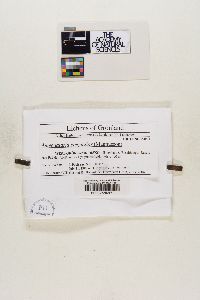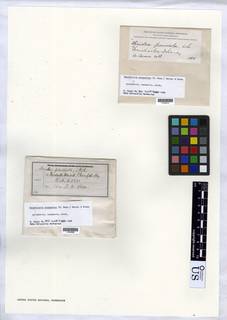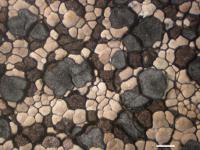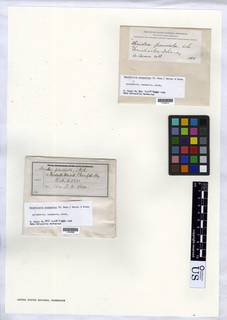
- Home
- Search
- Images
- Species Checklists
- US States: O-Z >
- US National Parks
- Central America
- South America
- US National Parks
- Southern Subpolar Region
|
|
|
|
Family: Lecideaceae
[Huilia elegantior (H. Magn.) Hertel, moreLecidea elegantior H. Magn.] |
Thompson, J., 1997. American Arctic Lichens: The Microlichens. Thallus ashy or waxen, yellowish white to pinkish or yellowish pink, over a black hypothallus, crustose, 1-2 mm thick, bullate-areolate, the areolae to 2 mm broad, often fissured, the exterior areolae often very rounded, the central ones more angular; esorediate; large cephalodia granular, red to waxy brown. Apothecia common, usually between the areolae, 1-2.5 mm broad; margin thick, persistent, flexuous to angular, sometimes becoming immarginate; exciple thin, black, shining; epithecium olive-brown, inspersed, excipular tissue blue-green, laterally on apothecium, brown-black or red-brown below, grading into hypothecium; subhymenium 50 µm, red-brown below to pale above; hymenium to 185 µm, hyaline; paraphyses conglutinate, slightly branched, only slightly thickened above to 2.5-3.5 µm; spores 8, biseriate, simple, hyaline, ellipsoid, halonate, 18-35 X 7-16 µm. Reactions: cortex K- or K+ yellowish, C+ red, KC+ red, medulla K-, P+ weakly orange in spots, C-, I- or rarely I+ weak blue. Contents: gyrophoric acid, traces of lecanoric acid (Hertel & Leuckert 1969). Race I with gyrophoric acid, II with confluentic acid, glomelliferic acid and Lecidea 2 (Inouue 1984). This species is found on moist, acid rocks, usually somewhat sheltered. Like its related species A. panaeola, it is circumpolar arctic-alpine and seldom collected. Its range seems to extend a bit farther south than that of A. panaeola. |





























